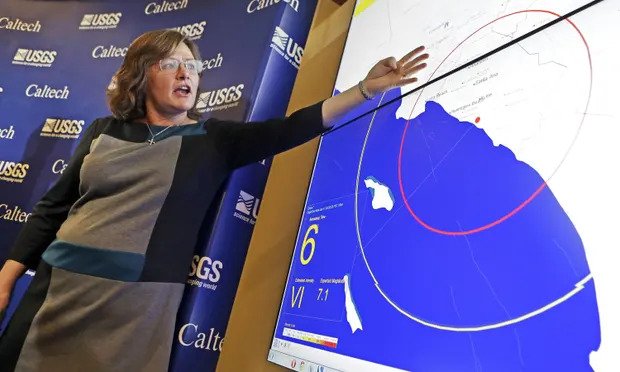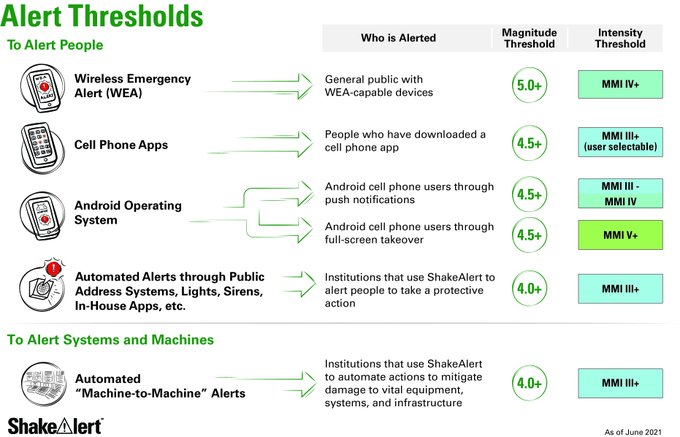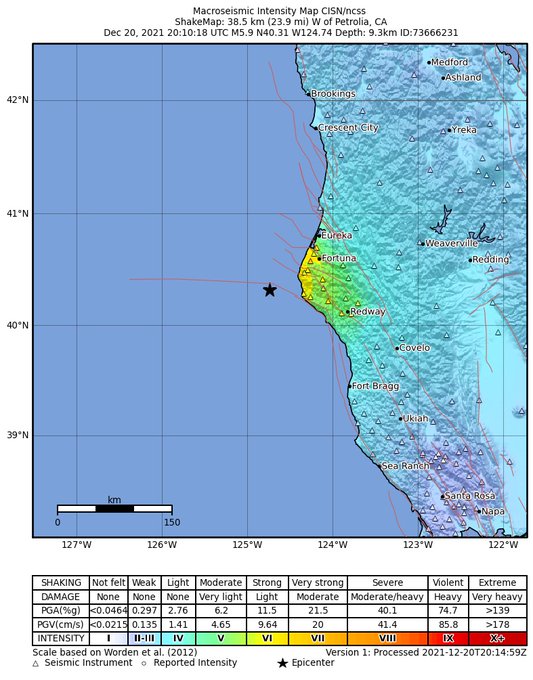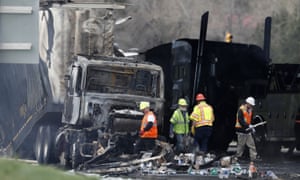Half a million phones received emergency alerts thanks to system offering a few seconds to take cover.
 Dr Lucy Jones, a seismologist, describes how an early warning system would work at a news conference in 2013. Photograph: Reed Saxon/AP
Dr Lucy Jones, a seismologist, describes how an early warning system would work at a news conference in 2013. Photograph: Reed Saxon/AP
–
By Gabrielle Canon @GabrielleCanon
Last modified on 2021 Dec 21
–
In the moments before a 6.2-magnitude earthquake struck the northern California coast on Monday, roughly half a million phones began to buzz. An early-alert system managed by the US Geological Survey sent warnings out before the ground started to shake, giving residents in the sparsely populated area vital time to take cover.
The earthquake brought significant shaking but minimal damage in Humboldt county, about 210 miles north-west of San Francisco, and officials said it was an excellent test of the alert-system. It was the largest magnitude quake that’s occurred since the system, known as ShakeAlert, was officially rolled out across the west coast.
“We got some reports from folks that they got up to 10 seconds’ warning before they felt shaking. That’s pretty darn good,” said Robert de Groot, a ShakeAlert coordinator with the USGS.
–
–

–

–
–
ShakeAlert issues warnings through a series of agencies and apps including the MyShakeApp, public wireless emergency alert systems, and the Android operating system, powered by Google. A data package is created from information provided by USGS sensors and – within seconds – shows up on phones. Some apps that provide alerts are available to download but even some who didn’t have an app on their phone were notified. Affected individuals are instructed to drop, cover, and hold on. Having extra seconds to do so can save lives.
This event provided an opportunity for the scientists and system operators to test and improve ShakeAlert so it will be even better when the next big earthquake strikes. “We can run as many simulations and tests as possible but we are really going to learn the most from real earthquakes,” de Groot said. “It’s giving us the chance to use the system and learn how to do a better job of alerting people.”
The earthquake occurred just after noon and was centered off the coast, near a tiny town called Petrolia that’s home to fewer than 1,000 people. The nearest population center, Eureka, is about 45 miles north.
–
This 6.2 #Earthquake didn't seem to phase people in Northern California but it did cause some damage in this liquor store. No injuries were reported. pic.twitter.com/Oorp1VXQuM
— WYFF News 4 (@wyffnews4) December 21, 2021
–
–
That left only about 25,000 people in the range of strong or very strong shaking, according to the US Geological Survey, though residents as far away as Sacramento and the San Francisco Bay Area reported feeling trembling.
The Humboldt county sheriff’s office of emergency services did not issue any evacuation orders, though a few roads were closed due to rockslides. The US Geological Survey estimated economic losses of less than $10m and no fatalities.
Photos showed shattered store windows, broken bottles fallen into store aisles and tiles that had fallen loose from a commercial building’s ceiling. The area last suffered an earthquake of a similar magnitude in 1993, when one person died, according to the USGS.
–
–


–
–
“It was bigger than [anything] I’ve felt in a long time out here,” she told the Chronicle.
There have been dozens of aftershocks ranging from 2.6 to 4.5 in magnitude, according to the USGS, through Monday and Tuesday. Though the quake originated off the coast, it did not trigger a tsunami and the National Weather Service announced that there was not a threat of one.
Even as alerts improve, officials emphasized how essential it is for residents and visitors to earthquake-prone areas across the west coast to be prepared. “It is one tool in a larger toolbox,” said De Groot. Everyone should have an emergency earthquake kit, copies of important documents, and plenty of bottled water for each person in the household. “[ShakeAlert] is just an enhancement for them to use to keep safe.”
The Associated Press contributed to this report
–
–
For 10 years, the Guardian US has brought an international lens with a focus on justice to its coverage of America. Globally, more than 1.5 million readers, from 180 countries, have recently taken the step to support the Guardian financially – keeping us open to all, and fiercely independent. We couldn’t do this without readers like you.
With no shareholders or billionaire owner, we can set our own agenda and provide trustworthy journalism that’s free from commercial and political influence, offering a counterweight to the spread of misinformation. When it’s never mattered more, we can investigate and challenge without fear or favor. It is reader support that makes our high-impact journalism possible and gives us the emotional support and motor energy to keep doing journalism that matters.
Unlike many others, Guardian journalism is available for everyone to read, regardless of what they can afford to pay. We do this because we believe in information equality. Greater numbers of people can keep track of global events, understand their impact on people and communities, and become inspired to take meaningful action.
We aim to offer readers a comprehensive, international perspective on critical events shaping our world. We are committed to upholding our reputation for urgent, powerful reporting on the climate emergency, and made the decision to reject advertising from fossil fuel companies, divest from the oil and gas industries, and set a course to achieve net zero emissions by 2030.
Every contribution, however big or small, powers our journalism and sustains our future. Support the Guardian from as little as $1 – and it only takes a minute. Thank you.
Topics
Most viewed













